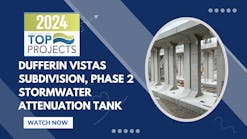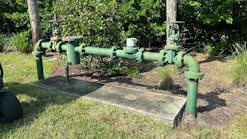Searching for workable ways to fund stormwater management and water-quality programs, communities across the United States are increasingly examining the option of stormwater utilities. National Pollutant Discharge Elimination System (NPDES) Phase I prompted a shift in the way many cities and counties view stormwater programs. For hundreds of other communities, NPDES Phase II is now having the same effect. The urgent need to upgrade or replace older infrastructures and states’ beginning to prescribe total maximum daily loads for polluted water bodies are also strong reasons to seek a consistent source of stormwater funding.
A stormwater utility is essentially a special assessment district set up to generate funding specifically for stormwater management. Users within the district pay a stormwater fee, and the revenue thus generated directly supports maintenance and upgrade of existing storm drain systems; development of drainage plans, flood control measures, and water-quality programs; administrative costs; and sometimes construction of major capital improvements. Unlike a stormwater program that draws on the general tax fund or uses property taxes for revenue, the people who benefit are the only ones who pay. “What I like about the stormwater utility process is that it’s more responsible government,” remarks Pat Collins, city engineer for Venice, FL, and president of the Florida Association of Stormwater Utilities (FASU). “Most communities have set it up so that all the money collected for the stormwater utility goes into an enterprise fund, and those dollars can only be spent on stormwater improvements for which they were collected. If you’re funding your program out of a general fund or property taxes, promises can be made that you’re going to get this capital improvement or you’re going to purchase a street sweeper for your stormwater program, but the county administrator or city manager might decide to build that new post office or that police department or something that’s more popular. Stormwater can get pushed to the side.”The up side of the stormwater utility concept is that it provides a degree of fairness lacking in tax-based systems. Property taxes are based on assessed property value, which does not necessarily correlate to the amount of runoff a parcel of land contributes to the overall stormwater problem. Under a utility, tax-exempt properties that generate runoff also must contribute their share to the stormwater fund. The down side is that the fee property owners pay is more visible to them than if the money came out of the general tax fund or through property taxes. Reluctance to pay has led to legal challenges in many communities that have sidelined proposed utilities and shut down existing ones.Despite some initial acceptance problems, though, the number of stormwater utilities is increasing rapidly. The first few stormwater utilities were started in the early 1970s. A 1994 Environmental Protection Agency report estimated the US total at just over 100. Today there are more than that in the state of Florida alone, and more than 400 nationwide, with high concentrations in Washington, Oregon, and California. By one estimate, the country will have 2,500 stormwater utilities within the next 10 years.Although Florida was an early leader in setting up stormwater utilities, a utility is not the only and, in some cases, best option. “There have been several communities in the state of Florida that have tried to pass a stormwater utility and have been unsuccessful, just because the communities themselves didn’t want to go with that approach,” notes Collins, who believes the number of utilities in Florida has leveled off. One sure sign of this, he says, is that consultants who used to work mainly with Florida communities in setting up the utilities are looking elsewhere for work, especially in the Southeastern US, as utilities become more popular there.Understanding Local Regulations and Taxes Vs. FeesA Natural Resources Defense Council survey of laws in all 50 states found that in almost all cases, municipalities can legally create stormwater utilities. If a particular state has no statute specifically delegating that authority to municipalities, precedent or the state attorney general’s office can help determine what is necessary to set up a utility. Typically two ordinances are needed: the first to establish the utility itself and the second to set the rate structure. Depending on state and local law, a general referendum may be needed for the first ordinance, or the city council or county board of supervisors may vote on it. Many nascent utilities have faced objections from property owners who claim the proposed stormwater fee is actually a tax. Municipalities generally have the authority to collect fees – defined as a charge for a specific service – but not the authority to assess taxes. Although exact definitions of “fees” and “taxes” vary from state to state, as a rule if the money collected by the stormwater utility exceeds the amount needed to pay for stormwater services and the excess is put to some other use, the stormwater charge may be considered a tax.Understanding state and local laws in this area is vital. In Lansing, MI, a stormwater utility was struck down in 1998 because the money collected was determined to be a tax rather than a user fee. That determination was based in part on the fact that more than 60% of the money collected was to be used for capital improvements, which would continue to be used by the city long after the current ratepayers had paid for them. Under Michigan law, the tax would have been permissible only if the city’s Ordinance 925, which provided for the collection of funds, had gone before the public for a vote. Because it had not, the Michigan Supreme Court ruled the stormwater service charge unconstitutional, and the utility was dissolved.Having a clear stormwater plan in place to demonstrate how the collected monies will be spent helps defend their “fee” status. Eugene, OR, formed its utility at the same time it adopted a comprehensive stormwater management plan, or CSWMP. “The primary impetus for us in forming a separate stormwater utility was the Phase I NPDES stormwater regulations, which just raised the awareness and the visibility of stormwater requirements,” states Fred McVey of Eugene’s public works department.“CSWMP was a planning process. It’s our stormwater facility master plan, and it was meant to be comprehensive in the sense of addressing all elements–not just drainage or conveyance, but also water quality and natural resource considerations related to stormwater. So that was really the major policy-level action.” Despite having a clearly articulated plan, he recalls, “It was a very challenging time in terms of dealing with customer questions and people feeling that it was somehow not a utility charge but a tax. A number of folks suggested they might be interested in pursuing legal challenges but didn’t end up doing that.”Brant Keller, director of public works and stormwater for Griffin, GA, and executive director of the Georgia Association of Stormwater Management Agencies, set up the very first stormwater utility in that state. NPDES II, a crumbling infrastructure, and lack of a comprehensive approach to stormwater management were the drivers. Even with the help of a professional engineering consultant–Griffin contracted with both Ogden Environmental and Energy Services Inc. and Water Resource Associates–Keller says successfully establishing a utility takes 14–24 months. Part of that time goes toward developing a comprehensive plan: evaluating the current situation and setting stormwater priorities; estimating costs in detail for three to five years and sketching them out for at least 10; examining potential sources of funding outside the utility; and addressing staffing and support needs.
At least part of the time should be spent examining potential legal challenges as well. “You’ve got to do your homework. You don’t just say, ‘OK, we’re in the business.'” Keller maintains that “you build a utility expecting to be sued. It might not be today, it might not be tomorrow. It might be 10 years from now. And if you don’t follow your program–or you don’t have a program–and you’re just using this for a revenue stream, it’s just another tax.” Selling It to the PublicBesides the suspicion that the stormwater fee is actually a tax, many proposed and newly formed stormwater utilities face an even more basic objection: People simply don’t understand what they’re for. “It’s a hard concept for the average customer to grasp–that stormwater needs to be managed,” McVey points out. “They see it as sort of a natural event and don’t always relate to the various services that it takes to operate a stormwater utility. I think the key point is to be very clear with customers about what the revenue goes for and to be articulate about the services that you’re delivering.”
Most communities do that through a combination of newsletters, public announcements in newspapers and on radio and television, Web sites, public workshops, and presentations to school and civic groups. “We had some citizen involvement and certainly some council-level involvement in adopting the new rates, so it was visible at that level for people paying attention to the local government meetings and hearings,” says McVey. “But we also launched a public education effort to get the word out about stormwater pollution. The public outreach was aimed at letting people know about the water-quality side of stormwater.”
Collins believes in emphasizing the inherent fairness of the system. “I think where a lot of them fail is by not getting the word out that it’s a dedicated funding source. It can only be used for stormwater.” When Venice established its utility in 1995, the then-city manager lowered the millage rate so that however much money was collected for the stormwater utility, an equal amount was removed from the general fund.
“Somebody once said, ‘You can either invite me up front to be a partner or you can invite me in the end to be a plaintiff,'” recalls Keller. Mindful of the risks–he believes about 25% of all utilities are challenged in court and knows hundreds of communities nationwide, including nearby Atlanta, have tried and failed to establish one–he has tirelessly educated the public about the need to collect stormwater fees, emphasizing that paying fees now will cost less than paying later through a special assessment tax.
Because Georgia did not require a general referendum for the stormwater utility to be approved but rather a vote of the city commissioners, Keller was also concerned about maintaining the commissioners’ support. “It can be very political. In some climates, if you vote in a utility, you won’t be reelected next time.” Keller started his public awareness campaign two years before the utility was established. “We went to every mom-and-pop program, every school program, every Kiwanis club, school board, and business. Douglas MacArthur said, ‘I shall return.’ Well, I never went away. I wanted to weed out far in advance any negative things we might see.”Determining User FeesNot only the amount that people are asked to pay, but how that fee is calculated, can determine how receptive they are to a utility. Most stormwater utilities base fees at least in part on the percentage of impervious cover of the parcels of developed land within the utility. For maximum fairness, some measure the square footage of each parcel (using county property maps, for example) and calculate the percentage of pervious and impervious surface individually for each. One widely used technique, the equivalent hydraulic acres (EHA) method, multiplies the pervious and impervious areas of each parcel of land – developed or undeveloped – by an appropriate runoff factor, adds the results, and multiplies the total by a water-quality factor to determine the fee based on the parcel’s relative runoff contribution. Many different fee-determining methods exist, however, and often fees apply only to developed land.
For simplicity, many utilities employ such methods only for commercial properties and simply charge a flat rate for residential properties. Griffin’s residential fee, for example, is $2.95 per month, which Keller says is close to the average monthly residential fee for existing stormwater utilities and just about the limit of what users are willing to accept. “Any more than three bucks will kill you.” Others charge a flat rate for each residential unit regardless of how many units are on a single parcel of land–each single-family home, mobile home, half of a duplex, apartment, and condominium is charged the same fee. Keller points out that time spent calculating rates for commercial properties is more cost-efficient than calculating individual rates for residential properties, whose rates don’t vary as widely. “You’ll go broke trying to nickel and dime a house.”
Some utilities further simplify fees by figuring out the average rate factor for each type of land use–residential, commercial, industrial, and agricultural–based on the typical percentage of impervious cover on land used for each purpose. Typical pollutants from each type of land may also be considered. All commercial properties are then charged at the same rate per square foot, all residential properties at another rate, and so on.
“We took an engineering approach to the way we apportion cost, and we assess folks based on the amount of runoff they contribute to the system,” Collins explains. In Venice, which has about 20,000 residents, credits are likewise offered for setting up flood control or water-quality measures. Collins believes people perceive this method of calculating costs as fairer than a flat rate, although he acknowledges, “Of course, it costs more to do it this way. I know that a lot of utilities around the state have started out by saying, ‘Let’s collect a dollar or two from every household,’ just to get folks used to paying a stormwater utility fee.”
Rather than send a separate stormwater bill, utilities often save money by piggybacking onto the existing water or sewer bill. The stormwater fee is broken out on a separate line so users can see exactly how much they’re paying. The utility sends separate bills only to property owners who are not served by the water or sewer utility. In some cases combined billing provides a strong incentive to pay: If the user doesn’t pay the stormwater portion of the water bill, water service can be discontinued. Finding Supplemental Funding SourcesEven with user fees in place, the cost of stormwater management in general and of large capital projects in particular often exceeds what the utility can generate. The FASU estimates that stormwater utility fees cover all administrative costs for just over half of its member utilities and capital costs for only 10% of the utilities.
A specific water-quality protection project may qualify for a grant under Section 319 of the Clean Water Act. Available to prevent and control nonpoint-source pollution, a 319 grant covers up to 60% of the cost of a project. Impact fees for new development and special local taxes are other potential sources of revenue. In Georgia, a Special Purpose Local Option Sales Tax provided about a million dollars of funding to Griffin’s stormwater program, which also received a state Emergency Management Agency grant to deal with some urgent flooding problems.
Once its stormwater utility was in place, the City of Venice, FL, used the stormwater fees as a guarantee to secure additional funds. “We put that up as our credit in order to get a higher rating so that we could float a bond,” explains Collins. “Sometimes we’ll need to borrow money to put together a capital improvement program, and we’ll use our stormwater utility fee as a pledge to pay back those monies.”
State revolving fund loans are another option. These low-interest loans pay for infrastructure investments such as wastewater treatment facilities, landfill closures, and habitat restoration. Federal and state funding provides the seed money, and repayment of earlier loans keeps the system going. As stormwater programs become more visible and mandates for improved water quality increase, these loans may be easier to get. In Florida, for example, lobbying efforts by the FASU increased the amount of such funding available for stormwater projects.
“A utility is part of the revenue stream, but it’s not all of it,” emphasizes Keller. “You’re looking for the holistic approach to watershed management, and a utility is just part of the program.”
At least part of the time should be spent examining potential legal challenges as well. “You’ve got to do your homework. You don’t just say, ‘OK, we’re in the business.'” Keller maintains that “you build a utility expecting to be sued. It might not be today, it might not be tomorrow. It might be 10 years from now. And if you don’t follow your program–or you don’t have a program–and you’re just using this for a revenue stream, it’s just another tax.” Selling It to the PublicBesides the suspicion that the stormwater fee is actually a tax, many proposed and newly formed stormwater utilities face an even more basic objection: People simply don’t understand what they’re for. “It’s a hard concept for the average customer to grasp–that stormwater needs to be managed,” McVey points out. “They see it as sort of a natural event and don’t always relate to the various services that it takes to operate a stormwater utility. I think the key point is to be very clear with customers about what the revenue goes for and to be articulate about the services that you’re delivering.”
Most communities do that through a combination of newsletters, public announcements in newspapers and on radio and television, Web sites, public workshops, and presentations to school and civic groups. “We had some citizen involvement and certainly some council-level involvement in adopting the new rates, so it was visible at that level for people paying attention to the local government meetings and hearings,” says McVey. “But we also launched a public education effort to get the word out about stormwater pollution. The public outreach was aimed at letting people know about the water-quality side of stormwater.”
Collins believes in emphasizing the inherent fairness of the system. “I think where a lot of them fail is by not getting the word out that it’s a dedicated funding source. It can only be used for stormwater.” When Venice established its utility in 1995, the then-city manager lowered the millage rate so that however much money was collected for the stormwater utility, an equal amount was removed from the general fund.
“Somebody once said, ‘You can either invite me up front to be a partner or you can invite me in the end to be a plaintiff,'” recalls Keller. Mindful of the risks–he believes about 25% of all utilities are challenged in court and knows hundreds of communities nationwide, including nearby Atlanta, have tried and failed to establish one–he has tirelessly educated the public about the need to collect stormwater fees, emphasizing that paying fees now will cost less than paying later through a special assessment tax.
Because Georgia did not require a general referendum for the stormwater utility to be approved but rather a vote of the city commissioners, Keller was also concerned about maintaining the commissioners’ support. “It can be very political. In some climates, if you vote in a utility, you won’t be reelected next time.” Keller started his public awareness campaign two years before the utility was established. “We went to every mom-and-pop program, every school program, every Kiwanis club, school board, and business. Douglas MacArthur said, ‘I shall return.’ Well, I never went away. I wanted to weed out far in advance any negative things we might see.”Determining User FeesNot only the amount that people are asked to pay, but how that fee is calculated, can determine how receptive they are to a utility. Most stormwater utilities base fees at least in part on the percentage of impervious cover of the parcels of developed land within the utility. For maximum fairness, some measure the square footage of each parcel (using county property maps, for example) and calculate the percentage of pervious and impervious surface individually for each. One widely used technique, the equivalent hydraulic acres (EHA) method, multiplies the pervious and impervious areas of each parcel of land – developed or undeveloped – by an appropriate runoff factor, adds the results, and multiplies the total by a water-quality factor to determine the fee based on the parcel’s relative runoff contribution. Many different fee-determining methods exist, however, and often fees apply only to developed land.
For simplicity, many utilities employ such methods only for commercial properties and simply charge a flat rate for residential properties. Griffin’s residential fee, for example, is $2.95 per month, which Keller says is close to the average monthly residential fee for existing stormwater utilities and just about the limit of what users are willing to accept. “Any more than three bucks will kill you.” Others charge a flat rate for each residential unit regardless of how many units are on a single parcel of land–each single-family home, mobile home, half of a duplex, apartment, and condominium is charged the same fee. Keller points out that time spent calculating rates for commercial properties is more cost-efficient than calculating individual rates for residential properties, whose rates don’t vary as widely. “You’ll go broke trying to nickel and dime a house.”
Some utilities further simplify fees by figuring out the average rate factor for each type of land use–residential, commercial, industrial, and agricultural–based on the typical percentage of impervious cover on land used for each purpose. Typical pollutants from each type of land may also be considered. All commercial properties are then charged at the same rate per square foot, all residential properties at another rate, and so on.
“We took an engineering approach to the way we apportion cost, and we assess folks based on the amount of runoff they contribute to the system,” Collins explains. In Venice, which has about 20,000 residents, credits are likewise offered for setting up flood control or water-quality measures. Collins believes people perceive this method of calculating costs as fairer than a flat rate, although he acknowledges, “Of course, it costs more to do it this way. I know that a lot of utilities around the state have started out by saying, ‘Let’s collect a dollar or two from every household,’ just to get folks used to paying a stormwater utility fee.”
Rather than send a separate stormwater bill, utilities often save money by piggybacking onto the existing water or sewer bill. The stormwater fee is broken out on a separate line so users can see exactly how much they’re paying. The utility sends separate bills only to property owners who are not served by the water or sewer utility. In some cases combined billing provides a strong incentive to pay: If the user doesn’t pay the stormwater portion of the water bill, water service can be discontinued. Finding Supplemental Funding SourcesEven with user fees in place, the cost of stormwater management in general and of large capital projects in particular often exceeds what the utility can generate. The FASU estimates that stormwater utility fees cover all administrative costs for just over half of its member utilities and capital costs for only 10% of the utilities.
A specific water-quality protection project may qualify for a grant under Section 319 of the Clean Water Act. Available to prevent and control nonpoint-source pollution, a 319 grant covers up to 60% of the cost of a project. Impact fees for new development and special local taxes are other potential sources of revenue. In Georgia, a Special Purpose Local Option Sales Tax provided about a million dollars of funding to Griffin’s stormwater program, which also received a state Emergency Management Agency grant to deal with some urgent flooding problems.
Once its stormwater utility was in place, the City of Venice, FL, used the stormwater fees as a guarantee to secure additional funds. “We put that up as our credit in order to get a higher rating so that we could float a bond,” explains Collins. “Sometimes we’ll need to borrow money to put together a capital improvement program, and we’ll use our stormwater utility fee as a pledge to pay back those monies.”
State revolving fund loans are another option. These low-interest loans pay for infrastructure investments such as wastewater treatment facilities, landfill closures, and habitat restoration. Federal and state funding provides the seed money, and repayment of earlier loans keeps the system going. As stormwater programs become more visible and mandates for improved water quality increase, these loans may be easier to get. In Florida, for example, lobbying efforts by the FASU increased the amount of such funding available for stormwater projects.
“A utility is part of the revenue stream, but it’s not all of it,” emphasizes Keller. “You’re looking for the holistic approach to watershed management, and a utility is just part of the program.”
About the Author
Janice Kaspersen
Janice Kaspersen is the former editor of Erosion Control and Stormwater magazines.





